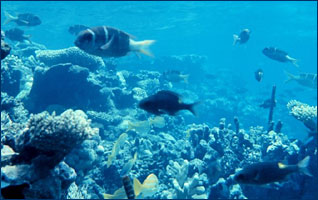The marine biome

Reef fish and coral off Eniwetok atoll in the central Pacific.
Marine regions cover about three-fourths of the Earth's surface and include oceans, coral reefs, and estuaries. Marine algae supply much of the world's oxygen supply and take in a huge amount of atmospheric carbon dioxide. The evaporation of the seawater provides rainwater for the land.
Oceans
The largest of all the ecosystems, oceans are very large bodies of water that dominate the Earth's surface. Like ponds and lakes, the ocean regions are separated into separate zones: intertidal, pelagic, abyssal, and benthic. All four zones have a great diversity of species. Some say that the ocean contains the richest diversity of species even though it contains fewer species than there are on land.
The intertidal zone is where the ocean meets the land — sometimes it is submerged and at other times exposed, as waves and tides come in and out. Because of this, the communities are constantly changing. On rocky coasts, the zone is stratified vertically. Where only the highest tides reach, there are only a few species of algae and mollusks. In those areas usually submerged during high tide, there is a more diverse array of algae and small animals, such as herbivorous snails, crabs, sea stars, and small fishes. At the bottom of the intertidal zone, which is only exposed during the lowest tides, many invertebrates, fishes, and seaweed can be found. The intertidal zone on sandier shores is not as stratified as in the rocky areas. Waves keep mud and sand constantly moving, thus very few algae and plants can establish themselves — the fauna include worms, clams, predatory crustaceans, crabs, and shorebirds.

From left: mussels, worms, and a spider crab at a hydrocarbon seep community in the Gulf of Mexico; a sea fan and brain coral in the Florida Keys National Marine Sanctuary; a school of Atlantic amberjack off North Carolina.
The pelagic zone includes those waters further from the land, basically the open ocean. The pelagic zone is generally cold though it is hard to give a general temperature range since, just like ponds and lakes, there is thermal stratification with a constant mixing of warm and cold ocean currents. The flora in the pelagic zone include surface seaweeds. The fauna include many species of fish and some mammals, such as whales and dolphins. Many feed on the abundant plankton.
The benthic zone is the area below the pelagic zone, but does not include the very deepest parts of the ocean (see abyssal zone below). The bottom of the zone consists of sand, slit, and/or dead organisms. Here temperature decreases as depth increases toward the abyssal zone, since light cannot penetrate through the deeper water. Flora are represented primarily by seaweed while the fauna, since it is very nutrient-rich, include all sorts of bacteria, fungi, sponges, sea anemones, worms, sea stars, and fishes.
The deep ocean is the abyssal zone. The water in this region is very cold (around 3° C), highly pressured, high in oxygen content, but low in nutritional content. The abyssal zone supports many species of invertebrates and fishes. Mid-ocean ridges (spreading zones between tectonic plates), often with hydrothermal vents, are found in the abyssal zones along the ocean floors. Chemosynthetic bacteria thrive near these vents because of the large amounts of hydrogen sulfide and other minerals they emit. These bacteria are thus the start of the food web as they are eaten by invertebrates and fishes.
Coral reefs
Coral reefs are widely distributed in warm shallow waters. They can be found as barriers along continents (e.g., the Great Barrier Reef off Australia), fringing islands, and atolls. Naturally, the dominant organisms in coral reefs are corals. Corals are interesting since they consist of both algae (zooanthellae) and tissues of animal polyp. Since reef waters tend to be nutritionally poor, corals obtain nutrients through the algae via photosynthesis and also by extending tentacles to obtain plankton from the water. Besides corals, the fauna include several species of microorganisms, invertebrates, fishes, sea urchins, octopuses, and sea stars.

From left: reef life in the Gulf of Aqaba, Red Sea; a reef at Fanning Island atoll in the central Pacific; a reef in the Florida Keys National Marine Sanctuary.
Estuaries
Estuaries are areas where freshwater streams or rivers merge with the ocean. This mixing of waters with such different salt concentrations creates a very interesting and unique ecosystem. Microflora like algae, and macroflora, such as seaweeds, marsh grasses, and mangrove trees (only in the tropics), can be found here. Estuaries support a diverse fauna, including a variety of worms, oysters, crabs, and waterfowl.

From left: Mangrove roots, south Florida; wetlands and tidal streams in the Ashe Island area, ACE Basin National Estuarine Research Reserve, South Carolina; a salt marsh in Winyah Bay National Estuarine Research Reserve, South Carolina.
 Freshwater |
 Marine |
 Desert |
 Forest |
 Grassland |
 Tundra |
Top photo: Dr. James P. McVey, NOAA Sea Grant Program. Oceans photos, from left: I. MacDonald, OAR/National Undersea Research Program (NURP) / Texas A&M University; Stephen Cook, National Oceanic and Atmospheric Administration / Department of Commerce; A. Hulbert, OAR/National Undersea Research Program (NURP) / University of North Carolina at Wilmington. Coral reef photos, from left: Mohammed Al Momany, National Oceanic and Atmospheric Administration / Department of Commerce; Dr. James P. McVey, NOAA Sea Grant Program; Mike White, National Oceanic and Atmospheric Administration / Department of Commerce. Estuaries photos, from left: OAR/National Undersea Research Program (NURP); aerial view and salt marsh from National Oceanic and Atmospheric Administration / Department of Commerce.
--
The original biomes pages were created in fall 1996 by the Biomes Group, Biology 1B class, section 115, at UC Berkeley; all were reformatted, with many new photos added, in March, 2007. Coral reef photo by Marguerite Gregory © 2004 California Academy of Sciences. The pages were re-designed in 2019 as part of a general UCMP website overhaul. Unless noted, content on these pages have not been updated.